

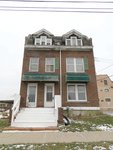
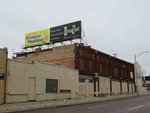



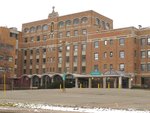
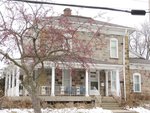

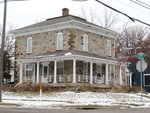

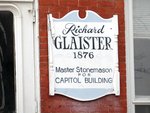

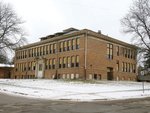
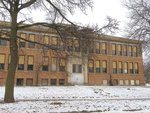

The architects, artisans, stonemasons and carpenters who built Lansing’s oldest structures are long gone. So are the boarders, shopkeepers, teachers, mayors and everyday folks who walked in and out of their doors.
But the walls still talk, and they are asking for help.
This winter, two local groups concerned over the fate of Lansing’s historic buildings— the Historical Society of Greater Lansing and Preservation Lansing — joined forces to compile a list of 10 “at-risk” architecturally and historically significant structures in the city.
The list, released this week in City Pulse, runs the gamut from large-scale landmarks like Lansing City Hall, Lansing Eastern High School and the Moores Park Pool to irreplaceable shards of urban history like the rare townhouse at 617 S. Capitol Ave. and the Glaister House, built by the stonemason who worked on the State Capitol, at 402 S. Walnut St.
The groups based their decision to put a building on the list on a combination of factors: “current state of repair; lack of any public plans for repurposing structures and importance of the structure to the built environment and the history of Lansing.”
Dale Schrader, president of Preservation Lansing, and Bill Castanier, president of the Greater Lansing Historical Society, stressed that the list isn’t meant to shame anyone.
Think of it as a stick-shaped carrot, designed to goose slow-moving owners out of inaction.
The owners are not necessarily bad guys. They run the gamut from concerned but harried individuals to indifferent corporate types to absentee ciphers. When contacted last week, some of the owners, like Joe Vitale, owner of the Cooley Haze House near Cooley Gardens, reaffirmed their intention to preserve the structures they own, attributing the idleness of their properties to the pandemic or economic factors. Others, like the gigantic Sparrow Health System — owner of two buildings on the list, historic St. Lawrence Hospital and the list’s biggest show-stopper, the former Lansing Eastern High School — made no such commitment. Owners of three vacant properties on the list didn’t return emails and calls or could not be reached at all.
When members of the Historical Society and Preservation Lansing combed the city, they easily came up with more than 40 entries, but decided to limit the list to 10, to focus on their top priorities. They visited every building on the list in person and went inside, if possible.
“This list is going to rub some people the wrong way, but it’s important to draw attention to these architecturally significant buildings that are threatened,” Schrader said. The city has a checkered record, at best, when it comes to historic preservation. Recent years have seen big renovation projects like the Ottawa Street Power Station, the Knapp’s Centre and the Marshall Street Armory. Even more encouraging, smaller buildings like the historic commercial block from 513 to 517 W. Ionia St. are threading the needle of time into a new life — as a hair salon, bookstore and brew pub.
“But demolition by neglect seems to happen a lot,” Schrader said. “There have been some successes, but we want to encourage people to continue. This is a one-way street. Once we lose a historic building, there’s no getting it back.”
1. Moores Park Pool
The 1922 J.H. Moores Memorial Natatorium, the oldest public pool of its kind in the nation, is the liquid opal at the center of this string of at-risk jewels.
Dale Schrader of Preservation Lansing said it might be the most architecturally and culturally significant property in the city, aside from the state Capitol.
Generations of Lansing kids have frolicked in this artificial hillside pool, perched over the Grand River like an urban mountain spring. Wesley Bintz, Lansing’s city engineer in the 1920s, parlayed its compact one-piece design (usually ovoid in shape) into a national phenomenon. From 1920 to 1950, over 120 Bintz pools sprang up across the country, from Massachusetts to Oklahoma. The words “Wesley Bintz Swimming Pool Designs, Lansing, Michigan,” or a variant thereof, is etched in bronze on every one of them.
The nation was going nuts over public recreation — Calvin Coolidge made speeches about the benefits of exercise — and Bintz pools were the hot franchise for cooling off. Bintz patented the design, quit his job with the city and started his own design firm. Today, fewer than 10 Bintz pools are operating. Lansing’s pool is unique, even in the Bintz-o-verse, because it is the only one tucked into a hillside, with an observation area. The spectacular view of the Grand River below and the three stacks of the Eckert Plant make for a memorable experience, even if you never dip a toe into the water. The pool was listed on the National Register of Historic Places in 1985.
Internet photos of defunct Bintz pools all over the country constantly draw comments like “that must have been really cool” and “so sad to see.” That hasn’t happened here — yet. In March 2021, a city report estimated it would take $4.8 million to complete a daunting list of deferred repairs, from the original piping underneath the pool to the concrete, the heater, the lights around the perimeter and more.
Organizers for the Friends of Moores Park Pool, formed after it was shut down in 2019, said the pool could be brought back to life for $2 million to $2.5 million. A public campaign raised $30,000 from 150 donors to help pay for the study, demonstrating widespread love for the pool. (Moores Park Pool also won City Pulse’s 2021 “Top of the Town” contest for Historical Place.) A spokeswoman said in May that the city is looking into grant funding for the pool and the allocation of $250,000 from the $2.2 million sale of the formerly Waverly Golf Course to developers in 2018, while support groups like Friends of Moores Park Pool gird for another round of fundraising. Stay tuned.
2. Townhouse at 617 S Capitol Ave.
This 1920 townhouse may not look like much at first glance, but it’s a rare dinosaur bone from the skeleton of old Lansing. A century ago, townhouses were a ubiquitous part of any vibrant downtown. They still pop up nearly every week on the cover of The New Yorker, but have almost disappeared here, with one exception: this three-story, two-unit structure, perched on the edge of the I496 freeway. Its neighbors demolished decades ago, but the building still seems to hunch its shoulders, like a straphanger hemmed in by passengers on each side. Look at it from the front, with your hands nearly closed in front of your face, and your mind can reconstruct block after block of these foursquare units. This townhouse, despite its modest frontage, contains over 8,000 square feet of space. The Historical Society couldn’t identify an architect, but records show that it was first used by an insurance underwriter. Over the years, it has served as apartments and small office rentals for lawyers and small claims adjusters. “Nothing’s been done with it for 10 years,” Dale Schrader of Preservation Lansing said. Broken windows, missing shutters and cracking trim attest to the neglect, but underneath, it’s clearly built like a brick house.
The owner listed by the county treasurer is 617 S. Capitol Properties LLC. Calls to the registered agents were not returned.
3. 900 Block of West Saginaw Street
Like a coral reef gone dry, the 900 block of West Saginaw is a gray husk with hardly a trace of its heyday as one of the most vibrant neighborhood commercial districts in the city.
Over the years, the block housed dozens of shops and businesses, including Gordon’s Men’s Wear, Stokes Men’s Clothing Store, the D&C dime store, two banks, the White Spot Grill, Frank’s Grill, Pasquale’s, and a self-service laundry with the fanciful name of Clearwater Washatoria. There were just as many beauty and barbershops, bars and restaurants, including the White Spot Lounge, West Town Restaurant, JB’s Saloon and the Saginaw Bar. The block often had more than two food stores at once, from Kroger’s, Bob’s Fruit Market, the Market Basket and A&P to Piggly Wiggly and Schmidt’s. In the 1950’s, downtown workers mingled with hungry shoppers and noshing cops at Paul’s Pastry.
Preservation Lansing’s Dale Schrader admits that revitalizing the block is a “tall order,” but he cited other commercial blocks in the city that have been massaged to life in Old Town and REO Town and downtown, revealing cool artifacts like the Beeman’s Grocery sign on South Washington Avenue and the original barber shop mirror from 50 years ago at the newly renovated Hair United salon downtown.
“A lot of the original materials are probably right under the stuff that has been added over the years,” Schrader said.
A major factor in the block’s demise was the expansion of Saginaw Avenue from two lanes, with parking, to a four-lane greased pole where people zoom from one side of town to the other with barely a glance. The city closed the block’s anchor tenant, Parks Furniture, in late 2020 because of “imminent safety issues.” Neil Park, the owner of Park’s Furniture and five other properties on the block, could not be reached for comment.
4. St. Lawrence Hospital, 1210 W. Saginaw St.
Hospitals as we know them today were nonexistent in Lansing until well past the turn of the 20th century. That alone makes St. Lawrence Hospital, built in 1924, a historic structure, but its grandly layered masonry and limestone trim identify it as on of the few “college Gothic” edifices still standing in the city of Lansing. The Woman’s Hospital Association operated a hospital in a series of Lansing homes until Edward Sparrow established the hospital that bears his name in 1912. St. Lawrence Hospital, the second hospital in Lansing, started in 1920 in a former sanitarium on Willow Street, until a new, 125-bed facility on Saginaw Street was built, thanks to a $100,000 donation from Lawrence Price. It’s no coincidence that the hospital picked St. Lawrence for its moniker. Price was not a saint, but he was one of Lansing’s leading industrialists and financiers, founder of Auto Body Co. and the first Lansing Brewing Co. and unsuccessful Democratic candidate for U.S. Senate in 1916. The cornerstone was laid in April 1923.
The building embodies a lot of history, from thousands of Lansing babies who started life there to nearly as many nursing students who trained there. Spokesman John Foren of Sparrow Health System, the building’s current owner, did not return a request for comment on the building’s fate.
5. Lansing City Hall
“Take me to the United Nations,” Cary Grant barks to a New York cabbie in Alfred Hitchcock’s 1959 film “North by Northwest.”
Would you settle for Lansing City Hall?
Clean, glassy modernist architecture has kept its allure from the 1950s through the “Mad Men” 2010s to the present day. Susan Bandes, an art historian at MSU and expert on mid-century modern architecture, has championed Lansing’s 1958 City Hall in many writings and talks, including an August 2017 City Pulse column.
“Lansing City Hall was built in a modern style, using the latest glass and steel construction because then-Mayor Ralph W. Crego wanted to project an image of the future, of the forward thinking city government,” Bandes wrote. The building’s design, by Lansing architects Lee and Kenneth Black, is a deliberate nod to famous International-style buildings in New York such as Lever House and the United Nations.
Sixty-three years later, the building needs over $50 million in repair work. The blue panels on the north face of the building, made of a fiberglass-wood composite that was cutting edge in the 1950s, are faded and worn in blotches that compromise their clean geometry. The building is drafty and inefficient. A grand indoor lobby graced with marble columns and Indiana limestone hardly draws a second glance today. The indoor fountain is capped, a lavish double staircase leads nowhere and plywood partitions hide an inert escalator. Leaks plague the underground parking garage. There’s a lot more, but you get the idea. After years of negotiations going back to the Virg Bernero administration, plans to move City Hall to a more efficient location and turn the glassy “Mad Men” slab into a high-end hotel and convention center have proven elusive. City spokesman Scott Bean did not respond to an email last week asking for an update.
6. Lansing Association of Women’s Clubs, 301 N. Butler Blvd.
Built in 1886, this unusual stone pile is a one-of-a-kind convergence of architectural rarity and historic significance. There are many stone structures left in Lansing, but few, perhaps none, can compare with the square-cut, straw and buff colored stone shell of the house on the corner of Butler Boulevard and Ionia Street, an enduring gem of the Italianate stonemason’s art. It was originally the 10-room home of Ulysses D. Ward, a Lansing pioneer and two-time Councilman. The Lansing Association of Women’s Clubs took it over in 1992.
The Women’s Club and its adopted clubhouse have a special significance in the life of Lansing’s African-American community. According to an account provided by the Greater Lansing Convention & Visitors Bureau, the purpose of the clubhouse was “to provide a designated meeting place for all minority women and to cultivate peace, harmony, and happiness among citizens irrespective of race, color or creed such that all people may enjoy a higher standard of living for peace and contentment.”
During the Jim Crow era, the club was a center for day care, after school programs and meeting site for African American clubs. The building is a stop on Lansing’s African-American Heritage Trail and was listed in the State Register of Historic Places by the Michigan Historical Commission in 1984. It has been idle during the pandemic, except for outdoor events, but there are plans to refurbish it resume activities such as family reunions and Halloween parties in the coming year, according to the Randy Watkins, a past president of the Lansing Association of Women’s Clubs. “It obviously needs work — painting, plaster, windows, porch repairs — I could name a lot of things,” Watkins said. “But overall, it’s a great little building.” The association is planning to launch a fundraising campaign, via GoFundMe or other means, to pay for the project.
7. Cooley-Haze House, 213 W. Malcolm X St.
The five-bedroom, 16-room Colonial Revival house is a miracle of survival tucked into a tiny oasis of green space, next to Cooley Gardens, choked on all sides by the General Motors Grand River Assembly Plant, the BWL’s new Central Substation and I496. Once among the most elite residences in Lansing, it was designed by leading architect Edwyn Bowd and built in 1903 for Eugene Cooley, the son of Western Michigan University Cooley Law School namesake and Michigan Supreme Court Chief Justice Thomas M. Cooley. Harry Haze, a doctor, owned it from 1817 to 1945. Michigan Gov. G. Mennen “Soapy” Williams and his family rented it during his first term in 1948 for $285 a month. After that, it was home to several organizations, including the Michigan Medical Association, and got a $250,000 facelift in the 1980s. The house’s last occupant, the Michigan’s Women’s Historical Center and Hall of Fame, moved out in 2017. The Lansing City Council voted unanimously in 2018 to sell the vacant house to local real estate agent Joe Vitale, a former president of Preservation Lansing, who plans to convert it into a workshop and retail store for recycling salvaged building materials.
Last week, Vitale said he’s still committed to preserving the house and carrying out his plan. He said that because of the pandemic, he’s focusing on residential restorations, including a 1914 historic house at 922 N. Walnut, and he’s wary of opening a retail store until conditions are more favorable. “He’s done some good preservation work, to his credit,” Dale Schrader of Preservation Lansing said. “But the Cooley Haze house is important, and people are wanting to see something happen there.” Vitale said he has taken precautions to protect the house’s interior from the weather and plans to resume work on the exterior in the spring.
8. Glaister House, 402 S. Walnut
Next time you’re circling around the state Capitol, take a break from cursing the maze of one-way streets and take a lingering look, while you can, at the cheerful red Glaister House, a miraculous survivor of the 19th century. Its last owner, Alice Sessions, was working with preservationists to establish a historic district for the house just before she died in 2018, but her son took over the property upon her death and sold it, without her knowledge, to Set Seg, an insurance agency located next door at the time. The house was built in 1876 by master stonecutter Richard Glaister, who worked on the State Capitol, and the workmanship shows it. It looks modest from the outside, but it has 14 rooms and did decades of service as a boarding house. Lansing Mayor Ralph Crego lived in it as a newlywed. Alice Sessions turned down multiple offers to buy the house over the years and invested $30,000 into repairs in 2017. Dale Schrader of Preservation Lansing said he was “heartbroken” when the race to preserve the house faltered after her death. About a year ago, Set Seg moved out of downtown Lansing and put the whole property, including the Glaister House, up for sale. Perched alone on a strategic corner close to downtown, where parking is the dominant land use, the house will doubtless face overwhelming commercial pressure to apply the wrecking ball, with no legal protection.
“Our only priority is to sell the property,” Set Seg Chief Financial Officer Dennis Rogoszewski said.
9. Eastern High School
This is the big one — by many measures, the largest and most significant historic structure in the city whose fate is still up in the air. In January 2016, the Lansing School District sold the three-story, 237,000-square-foot 1925 school and 18 acres of its surrounding campus to its next-door neighbor, Sparrow Hospital, for $2.475 million. The sheer weight of history embodied in the school, where generations of Lansing students spent their formative years, is only one of the building’s unique assets. Nothing in Lansing compares in size and craftsmanship to Eastern’s meaty brick and creamy masonry, arched windows embroidered with Indiana limestone and ornate auditorium, all topped by copper gutters and a slate roof. Ann Arbor architect Liz Knibbe has worked on the restoration of historic structures across the country, including Lansing’s Art Deco Knapp’s Centre. “It’s really beautiful,” Knibbe said. “You can’t replicate anything like that today.” Bob Christensen, National Register of Historic Places coordinator at the State Historical Preservation Office, called Eastern “one of the 25 or so key buildings in Lansing, from an architectural standpoint.” Across the United States, including Michigan, old school buildings like Ypsilanti High School, built in 1929, and Fremont High, built in 1926, are being put to a variety of uses. Their steel bones are strong, the ceilings are high, and old classrooms happen to be about the same size as modern efficiency apartments. It’s been proposed that Sparrow could take advantage of tax breaks available for historic properties and convert the building to housing for relatives of patients, lab or office space, or training centers, or find some more creative use, but eight years after the sale, Sparrow still has not made any plans public.
Asked specifically about the fate of Eastern in 2016, spokesman John Foren replied evasively that Sparrow is committed to “the continued health, education, and economic growth of the area.” He did not reply at all when we asked for an update last week.
10. Genesee Street School, 835 W. Genesee
The Genesee Street School is the kind of solid, reassuring building that pins down a neighborhood’s fabric, like a button on a sofa. The orange-tan brick walls, the perfect complement to autumn leaves, announced “back to school” from the day it opened in 1912 until it closed its doors in 1984, making it one of the longest-lived elementary schools in Lansing. The building was leased to the Black Child and Family Institute from 1986 to 2012. Designed by master architect Edwyn Bowd, who designed many iconic buildings in Lansing and at MSU, the school is listed on the National Register of Historic Places. Like many centenarian survivors, it has suffered a few indignities over the years. A one-story addition broke up its clean lines in 1962. The grand main entrance is graced by a striking feature architects call a “broken pediment” (it’s broken on purpose, for dramatic effect), but the entire entrance has been unceremoniously blocked in. To add insult to injury, an air vent takes place of pride in the center of the nonexistent door. Nevertheless, the strong bones and lovely bricks of a historic school attracted Lansing resident and investor Julian Darden, who announced a plan to convert the building into about 30 lofts in May 2019. It’s the latest in a series of plans to re-use for the building that have come and gone, but last week, Darden said the project is still a go. “COVID and everything has kind of set us back a little bit,” Darden said. He also cited supply chain delays and unexpectedly high “soft costs” of planning and permitting. “But we’re closer to getting some plans to the city, hopefully in the next couple of months.”
Support City Pulse - Donate Today!
Comments
No comments on this item Please log in to comment by clicking here